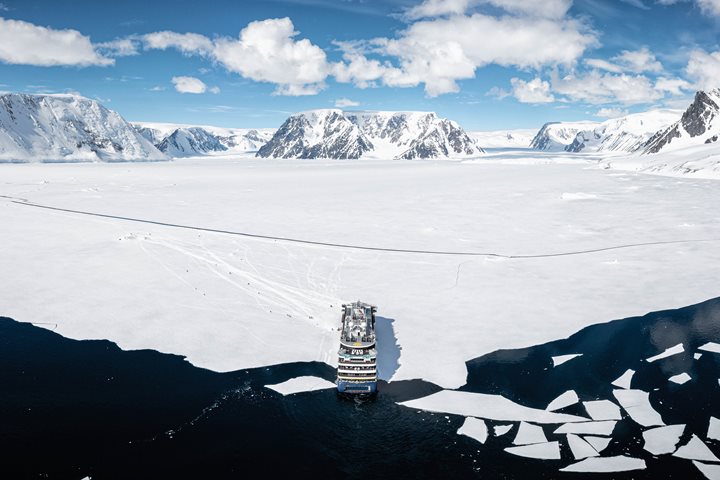Call +1.800.397.3348 or contact your travel advisor
Edith M. “Jackie” Ronne never intended on visiting Antarctica, but an uncanny chain of events led to her living and working there for over a year, becoming an Antarctic explorer in her own right.
In January 1947, en route to Antarctica, Edith Ronne’s husband Commander Finn Ronne invited her to fly down to Texas to christen his private expedition ship, the Port of Beaumont. Ronne (who went by "Jackie," a childhood nickname she picked up in Girl Scout camp) arrived with a single small suitcase containing, as she put it, “a good suit, a good dress, nylon stockings, and high-heeled shoes.” Get Inspired By Photos, Videos, Webinars, Stories, And Exclusive Offers. Sign Up
While loading the ship for departure, the crane cables unfortunately failed, dropping and destroying the aircraft that was required for mapping large portions of the Antarctic continent. Unfazed by the accident, Commander Ronne flew back to Washington, D.C. to procure a new airplane while sending his wife ahead to Panama to keep the expedition on schedule.
When Ronne's husband finally joined her, he convinced her to stay on board the ship, insisting that as a non-native English speaker, he needed her help in managing communications with government and media. At first, Ronne refused, but eventually wrote home that she was considering staying for the duration of the expedition. Before departing Valparaiso, Chile, Ronne received a letter from her aunt, warning her not to go, as Antarctica would “ruin her complexion.”
A Pioneer in More Ways than One
In her diary, Ronne wrote, “Finn needs me and I am going with him.” And so she became the 23rd member of the Ronne Antarctic Research Expedition, serving as the official recorder, historian, and newspaper correspondent. Unbeknownst to the crew, Commander Ronne legally designated his wife as expedition leader should something happen to him—and rightfully so, she had assisted in the extensive plans and preparations for the expedition, and he felt she was best equipped to fulfill the scientific aims of the mission. Ronne became the first woman to serve as a working member of an Antarctic expedition, the first woman to overwinter in Antarctica, and the first American woman to set foot on the Antarctic continent.
Despite vowing to never return, Ronne made a total of 16 trips to Antarctica, including a trip to the South Pole with her husband in 1971.
Together, Ronne and her husband lived and worked in a 12-foot by 12-foot hut based on Stonington Island in Marguerite Bay (on the Antarctic Peninsula). She wrote newspaper articles and dispatched official reports several times per week via teletype, while also assisting him in making flight plans over what remained as the last true terra incognita in the world. Ronne also served as a flight crew member on several of these missions, and she assisted with scientific work across many disciplines, from geology to oceanography.
Historic Antarctic base on Stonington Island overlooking glaciers.
After 86 landings on unscouted snow, hundreds of flight hours, and 14,000 aerial photographs covering a quarter of a million square miles, the Ronne Expedition managed to map the last uncharted wedge of Antarctica, which Commander Ronne christened “Edith Ronne Land” after his wife. It was later registered as the Ronne Ice Shelf which is how it is still known today. This newly updated map confirmed that the Weddell and Ross Seas were not connected, thereby defining the Antarctic landmass as a single continent.
Confronting the Dangers of the White Continent
Despite its significant scientific accomplishment, the Ronne Expedition faced several setbacks and difficulties. Crew dynamics were often strained. Their three airplanes had to be dug out of the snow constantly. Vicious storms with 100 mile per hour winds trapped crew indoors for days on end. Accidents were frequent: one crewmember walked backwards off a towering ice cliff, crashing through the sea ice before being miraculously pulled out alive. One air force pilot slid on the ice headfirst into the moving propeller of his plane, saved only by his thick fur hat; for medical attention, he flew himself back to the main base where his bleeding head was stitched up.
Returning to a heroes’ welcome in New York Harbor in 1948, Ronne recalled the expedition as, “an extremely difficult experience. I was under enormous tension the entire time….The most difficult part is being in isolation with the same group over a long period of time. Even the way a man puts on his socks in the morning begins to irritate you.”
A Woman of Diverse Talents and a Fearless Spirit
Although Ronne was successful in her own right, the true extent of her contribution to Antarctic exploration, geography, and science may never be fully appreciated. While she earned a few bylines in the New York Times, the majority of her records and findings were published under her husband’s name. She edited his four books on Antarctica extensively, seeing that they were all based largely on her notes.
Moreover, her accomplishments as an explorer were often overlooked in favor of the novelty of a suburban American woman traveling to such an exotic place. Newspapers of the day framed Ronne’s monumental work with headlines like, “Leader’s Wife Undaunted by Antarctic Rigors” and “Washington Housewife In Antarctica.” Others merely described her as “an attractive former State Department employee,” while the New York Times wrote, “Far from being the robust type one might expect to undertake an experience that has driven explorers insane, Mrs. Ronne is young and winsome.”
Yet her passion for Antarctica outweighed the challenges of navigating a male-dominated world. She acknowledged that traveling to Antarctica, “made my life. It opened up vistas and opportunities that I would have never had otherwise... Old time explorers were all captivated by the beauty, the isolation, and nature in the raw. Invariably, they all wanted to return in time...and so it was with me.”
For the rest of her life, she served as a de facto ambassador of Antarctica, writing and lecturing about the continent and publishing her memoir, First Lady of Antarctica. Edith "Jackie" Ronne passed away in 2009 and was buried next to her husband in Arlington Cemetery with the epitaph, “Antarctic Pioneer.”



